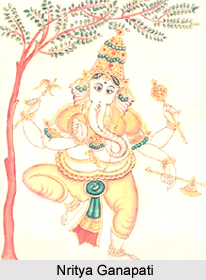 Nritya Ganapati is the 15th form among the thirty-two forms of Lord Ganesha. Nritya Ganapati means the Happy Dancer and He is portrayed in dancing posture under Kalpavriksha or the wish-fulfilling divine tree. Lord Ganesha appears in golden complexion with four hands and stands on a single leg. The popular Hindu god carries His own tusk, an elephant goad, a noose and a battle-axe in his hands. Lord Nritya Ganapati wears rings on his fingers and his curled trunk holds a Modaka (sweet ball).
Nritya Ganapati is the 15th form among the thirty-two forms of Lord Ganesha. Nritya Ganapati means the Happy Dancer and He is portrayed in dancing posture under Kalpavriksha or the wish-fulfilling divine tree. Lord Ganesha appears in golden complexion with four hands and stands on a single leg. The popular Hindu god carries His own tusk, an elephant goad, a noose and a battle-axe in his hands. Lord Nritya Ganapati wears rings on his fingers and his curled trunk holds a Modaka (sweet ball).
Devotees worship this form to Ganesha to achieve dexterity and success in fine arts. Different types of artists, particularly dancers, pray and venerate Nritya Ganapati. The most popular temples devoted to this god are Arulmigu Magudeshwarar Temple in the panchayat town of Kodumudi, Tamil Nadu; Pazhavangadi Ganapathy Temple in Trivandrum; Ganesha temples in Nanjangud and Chamarajanagar in the district of Mysore, Karnataka and others.
His devotees regularly recite the Nritya Ganapati Mantra in the worship of the Lord. The devotional hymn is stated below-
Pashankusha Kutaradanta Chanchatkara
Kalupta Varanguleeyakam
Peetamprabham Kalpatarodhashtham Bhajami
Nritthopa Padam Ganesham
Kalhaara Shali Kamalekshuka Chapa Bandanta
Prarohakagadi Kanakojwalangaha
Alinganaodhatakaro Harithangashtaya Devya
Karotu Shubhaha Murdhva Ganadhipo Mey.
This article is a stub. You may enrich it by adding more information to it. You can send your write-up at content@indianetzone.com









